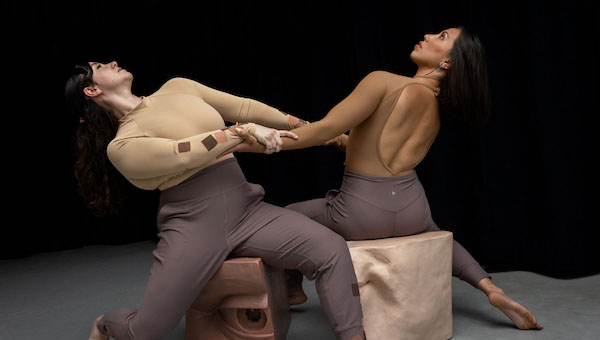Dance Review: Continuum Dance Project’s “Not Eye, Us” — A Call for Community
By Thea Singer
In this rigorous, timely dance-theater work, the performers provide a challenge to our beliefs and a salve for our hearts.

A scene from Continuum Dance Project’s Not Eye, Us. Photo: Melissa Blackall
Not Eye, Us, Continuum Dance Project’s evening-length dance-theater work presented at the Dance Complex in late November, brings the audience into the heart of the action and then sends them swirling to the outskirts to observe and reflect before reeling them back inside. The distinction between performer and viewer remains blurred throughout: together, the piece tells us, we are a community, each other’s keeper — regardless of our diverse backgrounds, perspectives, and roles in art and in the real world.
The sentiment may sound contrived, but in the hands of Fernadina Chan and Adriane Brayton, the co-directors/co-choreographers, and their four passionate dancers, its delivery is rigorous, timely, and — ultimately — a reminder of hope when we need it most.
Local artist Michael Alfano’s “Cubed” — a 4-foot-high sculpture of pigmented resin — sits at the piece’s physical and aesthetic center. It is a three-dimensional “puzzle” comprising nine chunky pieces that, when they are stacked just so, form two faces: a male on one side, a female on the other, with one face right side up and the other upside down. Each piece is a different skin tone, shape, and weight. The dancers’ costumes — tights and stretchy long-sleeve tops — mirror a mix of the various shades, including small patches stuck like collections of large postage stamps on their arms and legs.
The piece starts with the audience invited, through gestures by the circulating dancers, to examine the space and the sculpture — to touch it flat-handed, to caress its curves and protrusions (that nose! those lips!), to rest a chin or a forehead on its top surface. As the score shifts through 10 now lilting, now crackling musical selections — from Philip Glass’s Aguas da Amazonia, No. 1: Madeira River to Taiko Drum’s Festival Taiko Drumming — the dancers break apart the sculpture and rearrange the pieces in myriad configurations, vastly expanding the stage space.

A scene from Continuum Dance Project’s Not Eye, Us. Photo: Melissa BlackallPhoto: Melissa Blackall
Mind you, this is no by-the-book exercise in interior decorating. What begins with deep pliés to place pieces gently on the ground morphs into lightning-quick kicks that send, say, a hunk of cheek crashing. The dancers — at points in solos, duets, trios or quartets — clamber atop single pieces or ones piled three or five high. There, they stretch into long arabesques or back arches that go on for days; two dancers appear as a figurehead on a ship.
At times the concept of Not Eye, Us along with its haunting movable facial parts, resonates more strongly than the choreography, and the insistence of the message can be a bit over the top. However, what stays with you is not so much the originality of the movement phrases but the power and lucidity of their execution. The dancers provide a challenge to our beliefs and a salve for our hearts. In one sequence, Mayra Hernandez, at once spritely and elegant, elongates her limbs and even her head so far from her torso she conjures up a vibrating five-pointed star. In another, Adrienne Brayton escorts Sarah Pacheco around the inside of a circle formed by the audience, now seated around the stage space. Before Brayton approached her, spasms shook Pacheco’s shoulders, her back arced to near-breaking point. Now Brayton leads her, a hand on her lower back, looking into our eyes. We are bearing witness, participating while also watching.
In the end, Not Eye, Us is a dance about not just looking but also seeing, our seeing one another, perhaps as part of a group — by race, by gender, by role as actor or viewer — but also as distinct in our own selves. The dancers underscore that, cupping their hands around one of their eyes and passing the gesture from performer to viewer and so on, like a leitmotif. We, too, are an integral part of the story.
Thea Singer is a longtime dance critic and science writer based in Brookline, MA. Her articles have appeared in numerous publications including the Washington Post, Boston Globe, Scientific American, MORE magazine, O the Oprah magazine, Psychology Today, Huffington Post, Boston magazine, the Daily Beast, and Nature Outlook.
